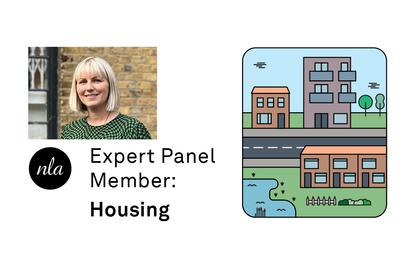London’s housing targets…and what’s driving them

Tibbalds

Housing is very clearly one of the major issues of the day and in London in particular there are significant pressures in communities as young people, essential lower paid workers, students and others try to figure out the best way they can find a home close to the things they need at an affordable rate. It puts great focus on London’s mayor and on his plan, and with a new Mayor often comes new ideas and new solutions. The current mayor is no exception, and he’s putting new challenges and solutions forward for local authorities to deal with. The recent consultation on the London Plan has seen many authorities react strongly to raised housing targets. Much of this reaction is coming from the outer London authorities, but in inner London the pressures to find space for increased housing targets is also growing.
I recently looked at the background to the current housing targets for an Urban Design London event, and explored where the current challenges lie.
Background
In London, the Mayor is required to publish a Spatial Development Strategy (‘London Plan’) and keep it under review. It should only deal with matters of strategic importance, taking account of the principal purposes of the Greater London Authority, around economic development, social development and improving the environment.
The first London Plan was published in 2004. The current plan is a consolidated version of the 2011 Plan with four separate sets of alterations. It covers familiar ground; housing and population change, changes in employment and work, poverty and deprivation and, it being Boris Johnson’s plan, the legacy from the 2012 games.
The plan is based on a minimum need for 49,000 additional homes per year between 2015 and 2036 and a capacity for 42,000 homes per year (derived from the SHMA and SHLAA, more of which later). The gap between need and supply is to be ‘augmented’ with opportunity areas, large sites and town centres considered ripe for additional capacity. To help with design quality, the plan contains a density matrix and space standards to help to guide quality and design
But, replacement plans come with replacement Mayors.
Sadiq Khan published his London Plan in draft form in December 2017, and it was consulted upon until March 2018. It is substantially longer than previous plans, coming in at 530 pages (or so) and covers the period 2019 – 2041 with a review of targets in 2029. The timetable for progression of the Plan sees Examination from November 2018 and adoption towards the end of 2019.
The draft plan sets out, ‘A vision for how London should sustainably grow’; but not just grow – ‘Good Growth’ is key and defined in terms of rebalancing and integrating London’s communities. It plans for a population increase of 70,000 people per year, leading to a need for 66,000 new homes and 49,000 new jobs per year. It aims to accommodate growth within London’s boundaries (i.e. no encroachment on green belt, metropolitan open land or open spaces) and provides prescriptive design policies to achieve this.
The much increased need for housing between the adopted plan and the draft plan has seen annual targets rise significantly, especially in the outer London boroughs – 13 of them have seen their annual housing target grow by over 100% between plans (Merton has a 229% increase in its target). The figures are partly based on the assessment of sites of more than 0.25 hectares but also include ‘an assessment of small site capacity using a combination of trend data for certain types of development and an estimate of potential for intensification in existing residential areas’.
In terms of both the number of homes to be found from small sites and the proportion of the overall target for the borough, the outer boroughs are finding that this affects them more significantly than the inner boroughs. The plan sets a 24,500 home / year target on small sites; 68% of these are in Outer London
The Evidence
The number of new homes is determined through the Strategic Housing Market Assessment (SHMA). It estimates the number, tenure and size of homes by taking into account housing growth, affordability, backlog and comparing required stock with current stock. As well as determining the 66,000 target, it establishes the required type and tenure – 47% would need to be ‘low cost rent’ and 18% ‘intermediate’ and 55% should be 1-bed.
The capacity of land to accommodate new housing is determined by the Strategic Housing Land Availability Assessment (SHLAA). It pulls together a ‘long list’ of potential large sites (over 0.25 ha) identified from a range of sources e.g. previous SHLAAs, planning permissions, allocations and a ‘call for sites’. It includes over 11,600 sites in the assessment, though over 60% are deleted, excluded or unsuitable. The SHLAA generates a capacity figure, which can be assessed against the need and apportioned to the boroughs. The capacity on large sites across London is 40,070 per year, with 75% of this coming from planning permissions and allocations.
In the draft plan, the gap between the capacity and the need is closed by an assessment of small sites within the SHLAA. It considers two approaches to assessing the small site contribution – extrapolation and modelling – and favours the modelling approach. Extrapolation looks at past completions (over 8 years and over 12 years) and takes the trend forward. Modelling looks to consider the impact of policy changes within the London Plan and its impact on housing delivery across the city (Policy H2). The methods result in dramatically different figures:
Actual completions, 2004/5 to 2015/16: | 129,940 |
Extrapolation over 8 years: | 93,710 |
Extrapolation over 12 years: | 104,592 |
Modelled approach: | 245,280 |
The policy and the reaction
Policy H2 says that small sites will play a greater part in housing delivery and that local character evolves and will need to change. It asks boroughs to prepare design codes showing how housing can be accommodated in different locations. There have been concerns about this policy, and it will need further evidence presented to justify it at the forthcoming examination. Concerns include:
- Much higher target than has previously been achieved
- Not clear how such numbers can be achieved in reality
- Heritage / conservation area impact may have been underplayed
- Housing delivery test (from November 2018) – increased housing targets make London boroughs vulnerable to sanctions / penalties
- Higher density development requires greater design scrutiny (policy D6); ‘developing at densities above those of the surrounding area on most sites’
- Hence, skills gap / resource implication in producing additional guidance
- Conflict with emerging NPPF on protecting character (see below)
The Housing Delivery Test threatens intervention in local authorities where supply is well below the need, the level of intervention varying dependent on the undersupply.
The emerging NPPF supports good design, uplift in densities, standards and meeting housing need, but not necessarily at the expense of an area’s prevailing character (which may include residential gardens).
With the London Plan, the emerging NPPF and the Housing Delivery Test all progressing towards greater levels of certainty towards the end of the year, all eyes will be on which of the potentially competing demands wins out.
Related Updates

Lizzie Le Mare speaking at the Housing Finance Conference 2025

Tibbalds

Lizzie Le Mare joins NLA Expert Panel

Tibbalds
Stay In Touch
Sign up to our Newsletter
Subscribe to our newsletter to receive updates about making people friendly places.

